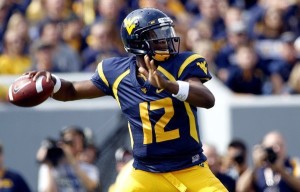by Chase Stuart
on April 3, 2013

Quarterbacks wearing #12 have won 14 Super Bowls.
What does it mean that
Geno Smith comes from a long line of
Mike Leach/
Dana Holgorsen star quarterbacks? I don’t know. At a minimum, it means he’s part of a very interesting and distinguished set of college quarterbacks. Because few players have dominated college football over the last 15 years like quarterbacks under Mike Leach and Dana Holgorsen.
Leach is one of the most fascinating characters in recent college football history, and he’s been one of the most influential coaches in the modern passing game. That’s what tends to happen when your quarterbacks produce video game numbers practically every season. Leach was the offensive coordinator under Hal Mumme at Kentucky in 1997 and 1998, which is when the Air Raid offense arrived on the national radar. At the time, there hadn’t been any Wildcats drafted in the first round since running back George Adams in 1985. Twenty-six months after Leach and Mumme arrived in Lexington, Tim Couch was the first pick in the NFL draft.
Leach then spent a year as the offensive coordinator for the Oklahoma Sooners with Josh Heupel at quarterback. Heupel led the conference with 3,460 passing yards and 30 touchdowns, and also sported the highest completion percentage (62.0%) in the conference. Those were big numbers in a conference where only four players threw for even 1900 yards, and was enough to land Leach the head coaching job at Texas Tech after only a season in Norman. When Leach moved to Lubbock, Texas in 2000, the quarterback cupboard appeared bare. He took unheralded sophomore quarterback Kliff Kingsbury and shaped him into the player that led the NCAA in pass attempts in 2000, 2001, and 2002. Klingsbury led the Big 12 in passing yards in both 2000 and 2001, and then as a senior, became just the third player in college football history to pass for 5,000 yards in a season (after Ty Detmer and David Klingler). Klingsbury went on to have an unremarkable career in the NFL before excelling as an assistant coach with the Houston Cougars. He followed then-head coach Mike Sumlin to Texas A&M after the 2011 season, and after turning Johnny Manziel into a Heisman Trophy winner, Kingsbury is now the new head coach at his alma mater.
[continue reading…]
Tagged as:
Dana Holgorsen,
Geno Smith,
Mike Leach
{ }
by Chase Stuart
on April 2, 2013
[House-keeping note: I’ve added the Salary Cap Calculator to the gray header tabs at the top of each page, so you can now easily get there no matter what page you’re on at Football Perspective.]
A quick look at Arian Foster‘s statistics over the last three years paints a picture of a player in decline:
| Year |
G |
Rsh |
RshYd |
RTD |
YPC |
YPG |
C/G |
Rec |
RecYd |
YPR |
TD |
YScm |
RRTD |
| 2010*+ |
16 |
327 |
1616 |
16 |
4.9 |
101.0 |
20.4 |
66 |
604 |
9.2 |
2 |
2220 |
18 |
| 2011* |
13 |
278 |
1224 |
10 |
4.4 |
94.2 |
21.4 |
53 |
617 |
11.6 |
2 |
1841 |
12 |
| 2012* |
16 |
351 |
1424 |
15 |
4.1 |
89.0 |
21.9 |
40 |
217 |
5.4 |
2 |
1641 |
17 |
Foster’s declined in rushing yards per game and yards per carry over the last two years, while his value in the receiving game fell off a cliff in 2012. One could reasonably conclude that Foster simply isn’t the same player he used to be, and that he could drop off even more in 2013. But while the traditional statistics tell one story, what do the advanced metrics say?
[continue reading…]
Tagged as:
Arian Foster,
success rate,
Texans
{ }
by Chase Stuart
on April 1, 2013
How much money *should* Tom Brady be paid? What are the appropriate cap figures for Tony Romo and Darrelle Revis? This series looks to derive the appropriate salary cap value for each player in the NFL.
Let’s start with the basics, which will include many generalities and rough estimates. I have chosen to ignore all players who are in the first three years of their rookie contracts; while we could try to determine the “fair market” cap values for Andrew Luck, Robert Griffin III and J.J. Watt, that would be nothing more than an academic exercise because their 2013 salary cap figures are set in stone. Instead, my goal is to determine the appropriate salary cap values for NFL Veterans (in this post, “Veterans” means all players with at least three prior years of NFL experience).
Note that ALL of the numbers in this post can be manipulated by each user thanks to the Salary Cap Calculator below. Your opinions regarding my assumptions should not interfere with your use of the salary cap calculator.
The salary cap in 2013 is $123.9M, but because players on injured reserve count against the cap, a buffer is needed to sign healthy players during the season. On average, each team will have placed on their roster 64 different players. Some of those players will be signed during the year and may only be on the team for a few weeks, so they won’t cost a significant percentage of the cap. On the other hand, a couple of players are usually on IR before the season even starts. Let’s assume that teams should spend 96% of their cap dollars on the healthy 53 players on their week 1 roster. The next step is figuring out how many of those salary cap dollars will go to non-Veterans.
[continue reading…]
Tagged as:
Salary Cap,
Salary Cap Calculator
{ }

